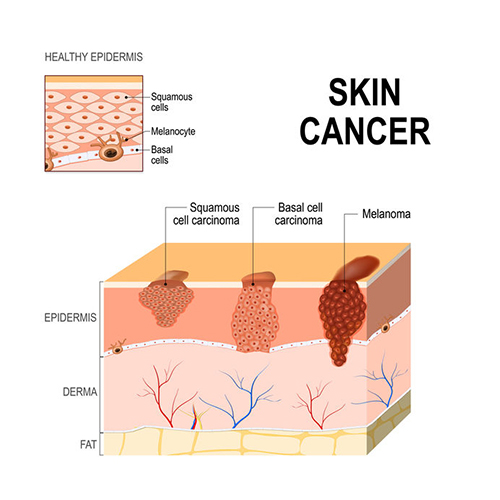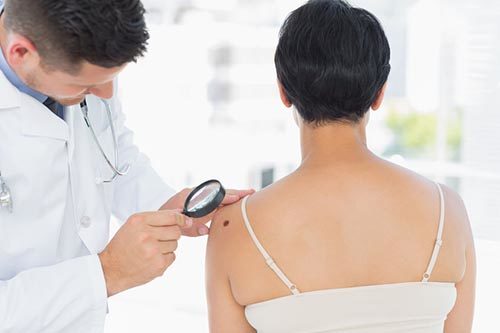Nonmelanoma skin cancer is the most common type of cancer in the United States. Since most types of skin cancer have a high cure rate at an early stage, skin cancer screening can help you know when to seek prompt treatment.
What is Skin Cancer?
 Your skin is your body’s largest organ, protecting your muscles and tissues from damage, weather, and sun exposure. Your skin may look like a single layer from the outside, but it is actually made up of several layers. Skin cancer occurs when cancerous (malignant) cells develop within any of the layers of your skin.
Your skin is your body’s largest organ, protecting your muscles and tissues from damage, weather, and sun exposure. Your skin may look like a single layer from the outside, but it is actually made up of several layers. Skin cancer occurs when cancerous (malignant) cells develop within any of the layers of your skin.
There are several types of skin cancer, which are grouped into two categories: melanoma and non-melanoma cancers. The group refers to the layer in which the cancer forms.
Nonmelanoma skin cancers – squamous cell and basal cell carcinomas – do not tend to spread to other parts of the body. These skin cancers are the most common in the US but are generally very treatable.
- Squamous Cell Carcinoma (SCC): A slow-growing cancer that develops in the squamous cells that form the topmost layer of the epidermis.
- Basal Cell Carcinoma (BCC): A slow-growing cancer that develops in the basal cells located directly below the squamous cells.
Melanoma cancer is a less common type of skin cancer; however, it is also the most aggressive and tends to metastasize (spread) to other parts of your body. This type forms in the melanocytes, the bottommost layer of cells in your epidermis. These cells are responsible for your skin’s pigment and color.
Screening tests for skin cancer can help detect the signs of cancer early so that you can seek treatment before malignant cells have spread. Early diagnoses can improve your chances of a fast recovery.
Screening for Skin Cancer
 Screening tests are a preventative step and generally happen when you do not have symptoms. When you start experiencing symptoms, it’s likely that cancer has started to spread.
Screening tests are a preventative step and generally happen when you do not have symptoms. When you start experiencing symptoms, it’s likely that cancer has started to spread.
A screening test for skin cancer starts with a skin exam. This exam is a noninvasive, visual exam during which your dermatologist will look for potential signs of skin cancer. During the exam, your dermatologist will look at skin lesions, growths, skin tags, and any other unusual areas on your skin. They will also look at moles, since melanoma – the deadliest type of skin cancer – can look very similar to moles in the early stages of growth.
While most screenings are only visual, a biopsy may be taken if your dermatologist finds an abnormality. This biopsy can determine whether cancerous cells are present. Some skin changes are benign and will never become cancerous, so Andover Dermatology can determine if the changes on your skin are normal or if further tests are needed.
Self-Screening at Home
Being aware of skin changes the best way to know when to visit us. We recommend performing a self-screening at home at least twice a year using the ABCDE’s of melanoma. Take note of new moles that appear on your body, or old moles that begin to change shape or size, and give us a call if you notice any changes.
 The ABCDE’s of melanoma are:
The ABCDE’s of melanoma are:
- Asymmetry: The edges of the mole do not mirror each other.
- Border: The borders of a mole are irregularly-shaped or jagged.
- Color: The color of a mole is not even but has several different shades of color.
- Diameter: The size of a mole is greater than ¼” (about the size of a pencil eraser)
- Evolving: The mole changes shape or size over time.
How is Skin Cancer Treated?
There are several different ways to treat skin cancer. The exact method used will vary from person to person depending on where the cancer is located, the size of the cancer, and the individual patient’s medical history. We may recommend one or a combination of therapies to ensure effective treatment of skin cancer.
- Cryotherapy: The use of freezing temperatures to kill off cancerous cells and shrink tumors.
- Electrodessication and curettage: The use of scraping and/or burning away layers of cancerous cells.
- Excisional therapy: A surgical procedure that removes a tumor or cancerous area of cells.
- Photodynamic therapy: A treatment that uses a combination of photosensitizing drugs and light waves to kill cancerous cells.
- Radiation therapy: A group of treatments that uses highly targeted beams of radiation to kill cancerous cells and shrink tumors.
- Topical applications: A variety of creams or drugs that are applied to the surface of the skin to treat skin cancer.
- Mohs microscopically controlled surgery: A type of surgery in which a tumor and small amount of surrounding skin are removed and examined for cancerous cells layer by layer until the treatment reaches healthy skin.
Skin Cancer Screening and Treatment at Andover Dermatology
At Andover Dermatology, we have over 30 years’ experience screening and treating skin cancer in the Andover, MA and Salem, NH areas. We do not offer Mohs Microscopic surgery; however, we have a wonderful network of skilled Mohs surgeons near both of our offices and are happy to provide referrals for this type of treatment.
Want to know more about skin cancer screening and treatment? Give us a call! We’re happy to answer any questions you may have.

